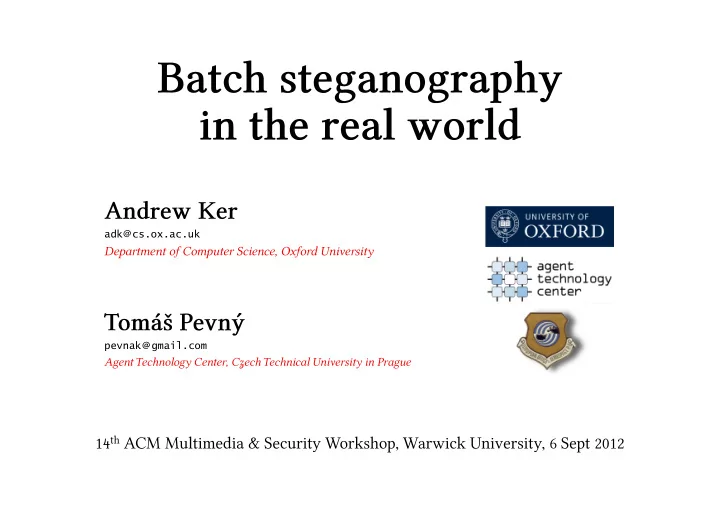

adk @ cs.ox.ac.uk Department of Computer Science, Oxford University pevnak @ gmail.com Agent Technology Center, Czech Technical University in Prague 14 th ACM Multimedia & Security Workshop, Warwick University, 6 Sept 2012
Is this a cover or a stego object? Warden What is the best classifier? How should I embed payload? payload Alice stego object cover source
Actor #1 Actor #2 Guilty How should I Actor embed payload in each image? How should I split payload Actor #n between images?
Who is guilty? How do I combine the evidence from Warden many images?
Little work published on these problems: • Some game theoretic work on highly abstracted versions, • No practical implementations. [Ker & Pevný, 2011-12] finally proposes a method for pooled steganalysis. Now we test batch steganography methods against it: • different payload sizes, • different hiding methods for individual images, • different strategies for allocating payload. ‘Batch steganography in the real world’ We limit ourselves to practically available methods and real-world JPEG images.
Guilty Actor How should I embed payload in Freely-available steganography each image? methods for JPEG images: ‘F5’ [Westfeld, 2001] ‘JP Hide&Seek’ [Upham, 2001?] ‘Steghide’ [Hetzl &c, 2005] ‘OutGuess’ [Provos, 2001] A reference method from the literature, which is not freely available: ‘nsF5’ [Kodovský &c, 2007]
Guilty Actor How should I A theoretical ‘optimum’ exists… split payload between use Gibbs embedding [Filler 2010] to images? minimize total distortion … but has caveats and is not freely implemented. Naïve options Let individual image capacities be the total payload is and the amount embedded in each image is ‘even’ constant ‘linear’ ‘max-random’ for enough covers, selected randomly ‘max-greedy’ for enough covers, with highest capacity
Warden Who is guilty? ‘Actor 1’ ‘Actor 2’ ‘Actor 3’ ‘Actor 4’ ‘Actor 5’ • Many actors, transmitting many objects each. • Different actors’ sources have different characteristics: model mismatch is guaranteed!
Warden Who is guilty? ‘Actor 1’ ‘Actor 2’ ‘Actor 3’ ‘Actor 4’ ‘Actor 5’ 1. Extract features. Use each actor’s output to estimate their overall distribution. 2. Compute a distance between each pair of actors. 3. Identify the steganographer(s).
Features • ‘PF274’ features: 274-dimensional features for JPEGs. • All features whitened (PCA) and rescaled (μ=0, σ 2 =1). Distance between actors • Maximum Mean Discrepancy: • Linear kernel: MMD=distance between actor’s feature centroids. Identification of steganographer(s) • Local outlier factor. Compares local density with density around k-nearest neighbours. • Ranks actors by level of suspicion.
On a leading social networking site… • some users permit global access to images they appear in; • we can click next image or see more of user (if user permits). Automated process of following links, restricted to ‘Oxford University’ users, resulted in 4,051,928 images from 78,107 uploaders. Ethics • All data anonymized. • Kept only images, grouped by ‘owner’, no personal information. • All images globally visible at the time of download.
On a leading social networking site… • some users permit global access to images they appear in; • we can click next image or see more of user (if user permits). Automated process of following links, restricted to ‘Oxford University’ users, resulted in 4,051,928 images from 78,107 uploaders. Data set • Selected 200 images from each of 4000 uploaders (actors). • Filtered only for triviality and standard JPEG quality factor. • Very challenging to work with.
• Select { 20, 50, 100, 200 } random images from each of { 100, 400, 1600 } random actors. • One is the guilty steganographer. • Various total payloads, embeded using { nsF5, F5, JPH&S, Steghide, OutGuess }, with strategy { even, linear, max-random, max-greedy } . • Rank actors by suspiciousness according to our steganalyser. • How often does guilty actor appear in top 5% most suspicious?
even n a = 100 actors, 1 guilty linear max-random n i = 100 images per actor max-greedy
even n a = 1600 actors, 1 guilty linear max-random n i = 100 images per actor max-greedy
even n a = 1600 actors, 1 guilty linear max-random n i = 100 images per actor max-greedy nsF5 F5 JPH&S Steghide OutGuess ? max-greedy max-random linear even
features of a cover image features of a stego image with payload length Expected because • embedding changes are roughly additive, • [Pevný &c, 2012] successfully trained a linear payload estimator.
features of a cover image features of a stego image with payload length 10000 random images
features of a cover image features of a stego image with payload length Expected because • embedding changes are roughly additive, • [Pevný &c, 2012] successfully trained a linear payload estimator. Consequence: all strategies should be equally detectable. (Detection depends on centroid of actors’ feature clouds.)
Features • ‘PF274’ features: 274-dimensional features for JPEGs. • All features whitened (PCA) and rescaled (μ=0, σ 2 =1). Distance between actors • Maximum Mean Discrepancy: • Linear kernel: MMD=distance between actor’s feature centroids. Identification of steganographer(s) • Local outlier factor. Compares local density with density around k-nearest neighbours. • Ranks actors by level of suspicion.
features of a cover image features of a stego image with payload length Whitened & normalized features 10000 random images
features of a cover image features of a stego image with payload length Whitened & normalized features some components are only noise
• The detector works in a wide range of situations. We confirm the relative security of hiding schemes, nsF5 F5 JPH&S Steghide OutGuess. • We can learn about good batch steganography. Of the naïve embedding methods, greedy is best. • The hider is exploiting a weakness in the detector… … (normalized) feature distortion is sublinear. • This is a consequence of noisy (uninformative) feature components. Is it unavoidable in an unsupervised steganalyser?
Recommend
More recommend